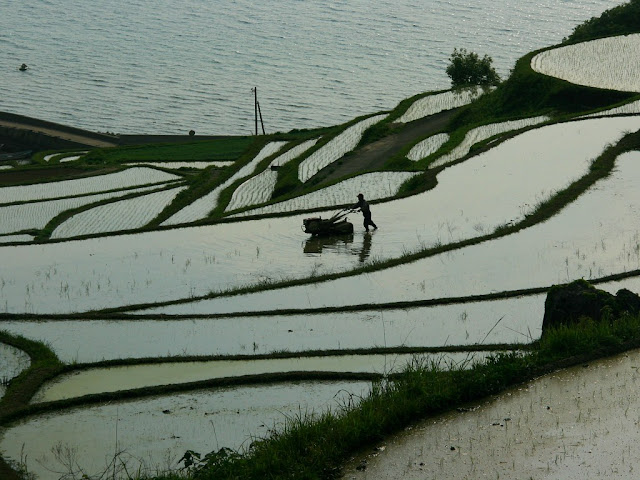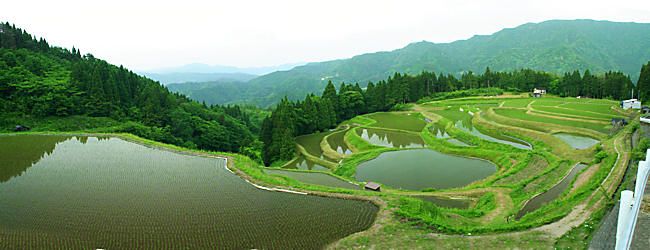 | |
| Doya-tanada, Fukushima-cho, Matsuura City, Nagasaki Prefecure At this terraced rice paddies, rice planting starts in the late April. (one of Japan's Top 100 tanadas) Photo by Yokaphoto.net |
Rice played a vital role in feeding the Asian expanding population. Now more than 90% of the world's rice is grown and consumed in Asia. Wet rice cultivation in Japan dates back to 3000 years ago. The Japan's population increased dramatically as the expansion of paddy fields increased rice production.
In Japan rice was levied as a tax in the middle of the 7th century. Peasants delivered rice to the Imperial Court until the 10th century, to their aristocratic lords in the middle ages, to feudal lords in the Edo Period, to landlords in the period between the Meiji Period and the postwar agrarian reform.
There were some areas which have little suitable lands for cultivating rice. Its residents couldn't pay tribute such as rice, local products to the Imperial Court. Instead, tax was paid in the form of labor.
The Tokugawa Shogunate imposed rice as tax on feudal lords according to production capacity of their lands. The feudal lords paid rice as stipends to their samurai retainers. They could gain cash by selling the rice.
At the Kannamesai festival in October and the Niinamesai festival in November, the emperor dedicates newly harvested rice to Amaterasu-Ohmikami, the Goddess of the Sun, an imperial ancestor. Unlike Kannamesai, the emperor eats these offerings at Niinamesai. The festival dates back at least to 677. Today the emperor plants rice for Niinamesai in May and harvests it in September by his own hands in the paddies of the Imperial Palace. Emperor Showa (Hirohito) started it.
Japan's earliest rice planting(replanting rice seedlings in rice paddy fields) starts in some islands of Okinawa in January. In many areas of Okinawa rice planting starts in March. Other areas starts planting rice from April to June. Most areas of the Kyushu Region start rice planting in June after harvesting wheat. Typhoons often destroy ready-to-harvest rice in Kyushu, so farmers are accustomed to plant wheat to ensure food security. Last month big earthquakes caused crack in rice paddies and leakage in the drainage pipe in Kumamoto. Many rice farmers can't still plant seedlings.
Many people had longed for stuffing themselves with white rice before Japan made the leap toward prosperity in the post war period. We were taught by parents or grandparents to eat every grain of rice in our bowl, to not waste food. When we left grains in the bowl they often said, "We are sorry for rice farmers." They told us not to waste crop that farmers paid hard work for." I eat every grain of rice in my bowl. Unfortunately consumption of rice is in a sustained decline due to the spread of Westernized diet. I eat bread for breakfast.
Tanada (terraced rice paddies along steep hills) is one of beautiful scenery, but it requires great care because much of the work is done by hand. Most of Tanada are preserved as a tourist spot.
| photo: 2012 田植え by na0905 /flickr |
The planting work was done by hand because each paddy is relatively small,
| 2012 田植え by na0905 /flickr |
| 2012 田植え by na0905 /flickr |
| 2012 田植え by na0905 /flickr |
| 100523_taue_akita by ivva /flickr |
rice planting machine
| rice planting. 田植え by T.Kiya /flickr |
Doya-tanada(土谷棚田), Fukushima-cho, Matsuura City, Nagasaki Prefecure
At this tanada, rice planting starts in the late April.
At this tanada, rice planting starts in the late April.
 |
| Doya-tanada Photo by Yokaphoto.net |
 |
| Doya-tanada Photo by Yokaphoto.net |
 |
| Doya-tanada Photo by Yokaphoto.net |
 |
| Doya-tanada Photo by Yokaphoto.net |
 |
| Doya-tanada Photo by Yokaphoto.net |
 |
| Doya-tanada Photo by Yokaphoto.net |
 |
| Ueyama no Tanada(うへ山の棚田), Kami Town, Hyogo Prefecture(one of Japan's Top 100 tanadas) photo by 神戸観光壁紙写真集 |
 |
Nishigaoka no Tanada西ヶ岡の棚田, Kami Town, Hyogo Prefecture
(one of Japan's Top 100 tanadas)
photo by 神戸観光壁紙写真集
|
 |
| Yamada no Tanada photo by 神戸観光壁紙写真集 |
Yamada no Tanada(山田の棚田), Kami Town, Hyogo Prefecture
 |
| Bekku no Tanada photo by 神戸観光壁紙写真集 |
Bekku no Tanada別宮の棚田,Yabu City, Hyogo Prefecture
 |
| Bekku no Tanada photo by 神戸観光壁紙写真集 |
 |
| Akiu no taue odori photo by MIYAGI PREFECTURE |
Akiu no taue odori (秋保の田植踊) is a traditional rice-planting dance in Akiu-cho, Taihaku Ward, Sendai City, Miyagi Prefecture. The dance was inscribed on the UNESCO Representative List of the Intangible Cultural Heritage of Humanity in 2009. The dance is performed at Nagabukuro Shinmeisha(長袋神明社, Shinto shrine) on the third Sunday of April, at Akiu Otaki Fudoson (秋保大滝不動尊, Buddhist temple) on April 29, at Yumoto Yakushido(湯元薬師堂, Buddhist temple) on May 5.
 |
| Akiu no taue odori photo by MIYAGI PREFECTURE |